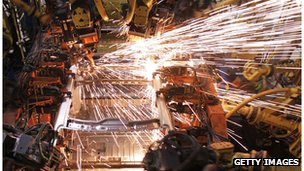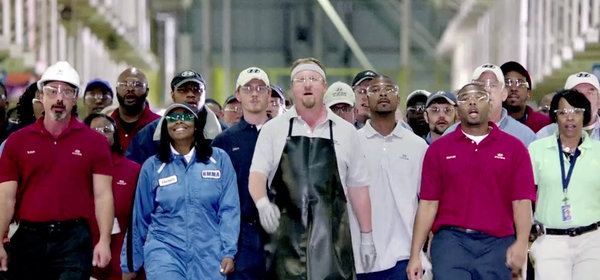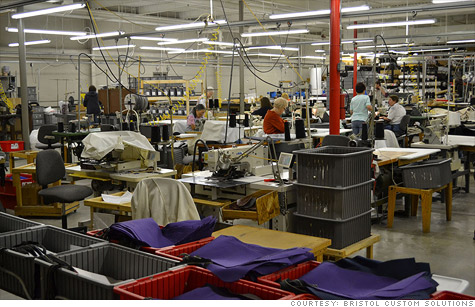 |
|
Source: Chesapeake Bay Candle
Chesapeake Bay Candle’s U.S. factory in Glen Burnie, Maryland.
|
By: Chris Morris, Special to CNBC.com
Published: Wednesday, 23 May 2012
Chesapeake Bay Candle never thought twice about offshoring its manufacturing when the company started 17 years ago. To make the product it wanted, each candle had to be handmade, and there was no cost effective way to do that in the United States.
Four years ago, however, the company reversed that thinking, centering its operations domestically, and betting that as the global economy changes, the move will actually save it money.
Chesapeake Bay, with a factory in Glen Burnie, Md., is hardly alone in rethinking its manufacturing plans these days. More and more American firms are bringing those operations home — and while it might be a little premature to call this “re-shoring” effort a movement, it’s certainly starting to become a trend.
President Barack Obama, in his State of the Union speech, noted that American manufacturers created new jobs in 2011 for the first time since the late 1990s. In a recent survey by MFG.com, an online marketplace that helps businesses find manufacturers for their products, 40 percent of the manufacturing firms it polled said they had benefited from work that had previously been sourced to a supplier in another country.
“[Consumer’s] desire to customize products is become more and more ravenous,” saysMitch Free, founder of MFG.com. “In order to stay relevant, [companies] have to be able to adapt very quickly. The way you do that is being somewhat close to your market. Instead of producing a big lot overseas and shipping it [here], companies can now rapidly assemble supply chains wherever they’re selling the product. They save on logistics costs. They take advantage of the local currency. And they generate good will in the market.”
MFG isn’t the only study that has pointed to an increase in re-shoring. A survey by the Boston Consulting Group in February found more than one-third of U.S.-based manufacturing executives at companies with sales greater than $1 billion are either planning or considering bringing production back to the United States from China.
Key Points
- Wages in China are climbing at 15 to 20 percent a year, according to Boston Consulting Group
- Speed to market is becoming more critical, as companies keep lower inventories.
“Companies are realizing that the economics of manufacturing are swinging in favor of the U.S., for goods to be sold both at home and to major export markets,” said Harold L. Sirkin, senior partner at the company. “This trend is likely to accelerate starting around 2015.”
For Chesapeake Bay, it was less a matter of customization as it was cost control.
The candle company originally based its manufacturing in China, but as anti-dumping laws (designed to prevent predatory pricing) began to impact duty rates, Chesapeake Bay took its operations to Mexico.
Unhappy with the manufacturing ecosystem there, it tried a few other countries, eventually landing in Vietnam in 2000 — a popular manufacturing hub for companies.
“The Vietnamese population is very young and it’s pretty abundant,” says Mei Xu, Chesapeake Bay’s co-founder and CEO. “The work ethics are very similar to those of the Chinese. They all want to work hard to provide a better life for their children.”
Labor costs, however, are on the rise in countries like China and Vietnam. BCG says wages in China are currently climbing at 15 to 20 percent per year, due to the demand for skilled labor. The group expects net labor costs for China and the U.S. to converge in the next three years.
Xu notes that Vietnam closely follows China’s lead on issues like salary and benefits. Today, the average salary for a manufacturing employee in the country is between $300 and $400 per month.
That’s still well below the $12.50 to $13 per hour employees in the United States can earn, but salaries only make up 20 to 30 percent of a product’s total cost according to BCG.
Other factors, meanwhile, such as shipping are seeing prices increase as well, due to rising oil prices. Xu says Chesapeake Bay noticed some shipping companies cutting back their overseas routes as well, which threatened the company’s turnaround time.
That speed to market is more critical today than ever as companies keep lower inventories on hand as a precautionary measure.
“When the economy was strong and the sales of product companies were strong, they were placing big orders offshore,” says Free. “They’d order a billion widgets and they’d get them shipped here. When the recession hit, they were stuck with that inventory, and that hit their profit margins pretty quickly. They knew it would cost more [to place smaller orders domestically], but it was a less risky capital outlay. And if consumer demand turned, they wouldn’t be stuck holding a lot of inventory they would have to eat.”
Meanwhile, advances in technology domestically have made it easier to be competitive with overseas companies.
“We have some new machinery and new methods that can be more competitive with China,” says Bruce Brandel, president of The Packaging Team, which supplies blister packaging for consumer product goods. “We’re starting to see people who moved to Mexico or China say ‘If you look at the total picture and cost, it’s not much of an advantage — and maybe a disadvantage — to be there’.”
For The Packaging Team, the degree of that competitiveness varies by product and order size, but the savings comes from new equipment Brandel says increases the speed of sealing packages ten-fold.
“If you’re spending $2 an hour there, you should be able to spend $20 an hour here with the machinery making up the difference,” he says. “Also, there are what I call soft costs [that go with offshoring]. Things like lost opportunities, being unable to meet timelines or dealing with late deliveries. What does that cost you?”
There are risks to re-shoring, too. Xu says Chesapeake (which has since transitioned to machine-filled candles) spent $5 million to secure a large factory in Maryland when it moved manufacturing here. That plant spans 125,000 square feet and can produce up to 2,000 candles per hour. But right now, it’s not being used to capacity.
The ability to ship product in two weeks versus six or seven is certainly beneficial, but there are overhead concerns. Xu notes that she remains optimistic, though. The number of people required on the manufacturing line is significantly lower in the U.S., which helps lower costs, she says.
Right now, the cost to make a candle in the U.S. is approximately the same as it is to make one in Vietnam, but Chesapeake says its betting it will see notable savings in the future, given the rising salary trends and fuel prices.
Despite what many people might think, capitalizing on the “Made in USA” movement is less of an incentive for many companies.
“In my opinion, there’s only one thing that runs corporations today, and it ain’t pride, it’s all dollars,” says Brandel. “[Made in America pride] is a good concept, but if the dollars don’t make sense, it isn’t going to happen. And maybe that’s the way capitalism is supposed to work.”
Even U.S. consumers don’t seem to be as passionate about it as many claim — though, ironically, there’s a notable demand for U.S.-made products in overseas markets — including China.
“If my Chinese consumers are asking for ‘Made in USA’ product, wouldn’t my U.S. customers do the same and pay a bit more?” says Xu. “Our [U.S.] customers, our buyers, are saying they value [an item that is] made in the U.S.A. if it’s the same price. … If it’s more expensive [at retail], there’s a pain threshold and we don’t know what it is — how much more they’ll pay.”











You must be logged in to post a comment.